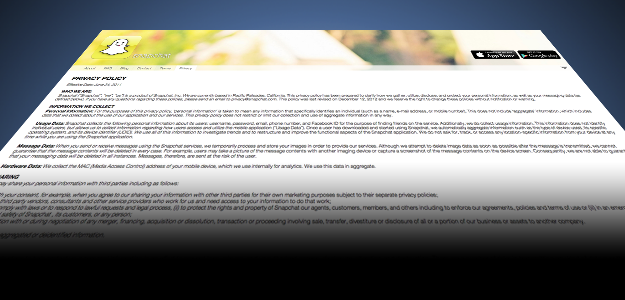 What are you really agreeing to when you click that fateful “agree” button? Terms & Conditions cuts out the legal lingo to spell it out in plain English.
What are you really agreeing to when you click that fateful “agree” button? Terms & Conditions cuts out the legal lingo to spell it out in plain English.
The most controversial mobile app on the market right now is, without a doubt, Snapchat. And for good reason: The app allows you to “snap” photos (and now video) that are automatically deleted a set number of seconds after you send them to someone. As you can imagine, this self-destruct feature has instilled a false sense for users that it’s possible to send embarrassing (read: naked) pictures without having to worry about those photos making their way into the digital wilds of the Web.
Of course, that’s just not true, since it’s quite easy to take a screenshot of these fleeting photos with pretty much any smartphone. A classy blog called “Snapchat Sluts” quickly popped up (then disappeared), featuring – you guessed it – naked photos of women taken with Snapchat.
Given the contentious and inherently naughty nature of Snapchat, a look at what the app’s terms of service and privacy policy are in order.
Note: Snapchat does not make it possible to link directly to either its terms or privacy policy; you just have to go to the website, and click the appropriate tab to access them.
Terms of service
Ordinarily, we’d have a whole bunch of knotty provisions to sort through. But such is not the case for Snapchat; it’s all very short and straight forward, which I like to see. However, it’s also not particularly encouraging.
A few rules
Unlike a lot of sites we’ve seen, Snapchat doesn’t lay out a bunch of rules for users to follow. But there are a few. Namely, don’t mess with the app in any technical way; don’t share copyrighted content; don’t use it to spam or harass anyone; and get permission to use it if you’re under the age of 13 (a stipulation that is explained in the privacy policy, not the terms of service, where it usually appears).
Hold the lawsuit
Not surprisingly, Snapchat has decided to make all its users agree that they will never, under any circumstances, hold the company accountable for any negative thing the might arise out of using Snapchat. This means that, if someone screengrabs a naked Snapchat picture of you and posts it to the Web, you can’t sue Snapchat. It also says that, if you do find a way to sue Snapchat, your damages may not exceed $1 – yes, just one.
This is called a “limitation of liability” clause, and is included in practically every website, online service, or piece of software on the market; so it’s not just Snapchat trying to pull one over on your (any more than any other company is). Also, some states do not allow for limitations on liability, so this may not apply to you, depending on where you live.
Privacy policy
Snapchat’s privacy policy is arguably the more important of its two site governance documents, given that the app is essentially built on the premise that there’s some stuff you would rather keep private. So, what does it say?
What Snapchat collects about you
Snapchat collects your username, password, email, phone number, and Facebook ID “for the purpose of finding friends on the service.” It also collects “usage information,” which the company says is anonymous. This information could be shared with third parties – which isn’t great, but is something you should basically assume is happening at this point.
Can Snapchat see my pics?
Of course, we probably all assume that much. But what about that photo of your freshly showered bum? Can some Snapchat lackey see that? The answer is, I don’t know. The privacy policy states that Snapchat will “temporarily process and store your images in order to provide our services.” But does this mean that some guy at the Snapchat offices can peek in on your pics? Perhaps not – but it’s possible.
The company goes on to say that, “Although we attempt to delete image data as soon as possible after the message is transmitted, we cannot guarantee that the message contents will be deleted in every case.” It then gives an example of someone taking a screengrab of a photo, over which Snapchat has no control.
I have reached out to Snapchat for clarification on 1) whether someone at Snapchat could ever have access to your actual photos; and 2) whether there are any instances in which Snapchat would store images on its servers for extended periods of time. I will update this space with any response I receive on this matter.
Location, location, location?
Another potentially troubling bit is Snapchat’s policy on location data. The privacy policy unequivocally states: “We do not ask for, track, or access any location-specific information from your device at any time while you are using the Snapchat application.”
Great! Right? Well, not so fast. A quick look at the “permissions” required of Snapchat for Android shows that the app requests to access you “approximate location,” which is based on “network location sources such as cell towers and Wi-Fi.” This is different than GPS location data, but is still location data.
I have also asked Snapchat to clarify its policy on location data collection. At the moment, it is not against the law for apps to collect location information on users without their knowledge or consent – a pitfall that Sen. Al Franken (D-MN) is trying to fill in with a new bill that just passed the Senate Judiciary Committee on Friday. But until then, we are at the app makers’ mercy. Let’s hope Snapchat has some.


